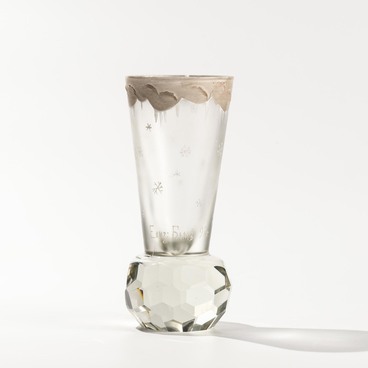This stemmed glass with a relief image of a goat’s head was made of colorless glass using the hand pressing technique. Pressing is a technique of forming glass products by pressing the glass mass into a cast iron mold. Hand pressing was known as early as the 16th century when glass pendants for chandeliers and mosaics were made. In the 18th century, hand pressing was used in Europe to make stoppers for decanters, goblet stands, salt cellars, and other small items.
Almost any glass is made using quartz sand mixed with other components, for example, saltpeter, soda, and potash. The mixture for preparing glass is known as the batch. Pressing is the most simple, fast, and inexpensive method of manufacturing glass products. Molten glass mass is loaded into a mold at a temperature of around 1100 ºС. After that, a ring is lowered onto the mold and the plunger starts pressing the viscous glass mass up, between the working surfaces of the body, plunger, and ring. The space between the body, mold, and ring corresponds exactly to the shape of the final product. When the pressed item is hard enough, it is extracted by using a portable tray or by toppling the mold over and put into a furnace for annealing. Pressing molds are made of metal and can be both single-piece and split, or multi-component. Pressing is typically used for producing thick-walled items because the glass mass is pressed against the mold walls forcibly and hardens quickly. Most often, pressed items do not require any additional processing. In this case, the surface of the goat’s face was achieved by etching with hydrofluoric acid.
The relief of the goat’s head on the stemmed glass possesses the unique ability of “changing the mood”. Stern and menacing on the outside, the goat turns into a kind, happy, and joyful creature with shining eyes on the inside, as the amount of drink in the glass decreases. This is achieved with the help of special optical effects and relief processing methods. Due to this amusing feature, in the 19th century, this stemmed glass belonged to the category of “fun” tableware. The stemmed glass is included in the factory’s price lists and has been produced since the 19th century to this day.
Almost any glass is made using quartz sand mixed with other components, for example, saltpeter, soda, and potash. The mixture for preparing glass is known as the batch. Pressing is the most simple, fast, and inexpensive method of manufacturing glass products. Molten glass mass is loaded into a mold at a temperature of around 1100 ºС. After that, a ring is lowered onto the mold and the plunger starts pressing the viscous glass mass up, between the working surfaces of the body, plunger, and ring. The space between the body, mold, and ring corresponds exactly to the shape of the final product. When the pressed item is hard enough, it is extracted by using a portable tray or by toppling the mold over and put into a furnace for annealing. Pressing molds are made of metal and can be both single-piece and split, or multi-component. Pressing is typically used for producing thick-walled items because the glass mass is pressed against the mold walls forcibly and hardens quickly. Most often, pressed items do not require any additional processing. In this case, the surface of the goat’s face was achieved by etching with hydrofluoric acid.
The relief of the goat’s head on the stemmed glass possesses the unique ability of “changing the mood”. Stern and menacing on the outside, the goat turns into a kind, happy, and joyful creature with shining eyes on the inside, as the amount of drink in the glass decreases. This is achieved with the help of special optical effects and relief processing methods. Due to this amusing feature, in the 19th century, this stemmed glass belonged to the category of “fun” tableware. The stemmed glass is included in the factory’s price lists and has been produced since the 19th century to this day.


